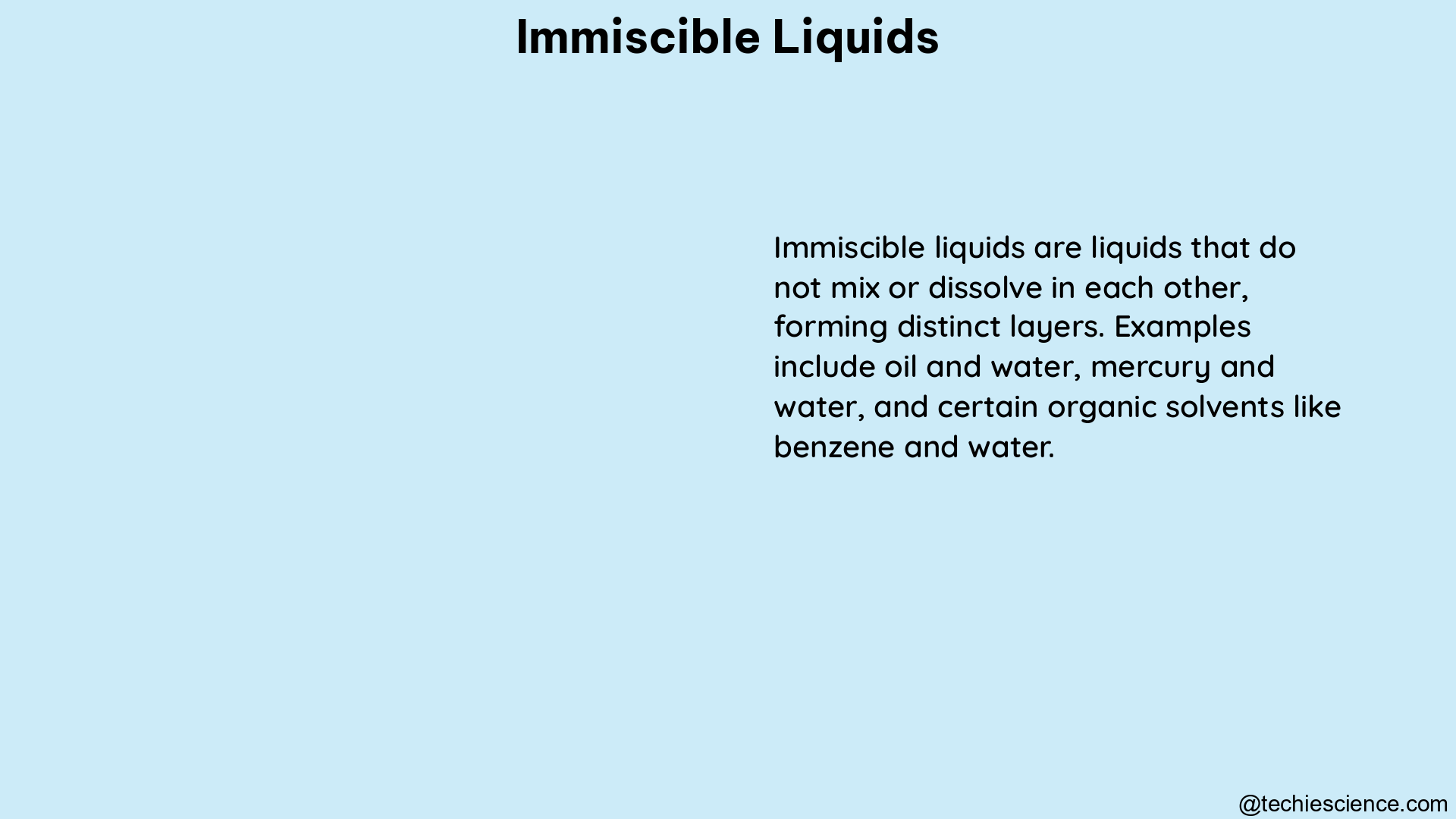Immiscible liquids are liquids that cannot mix together to form a homogeneous solution. These liquids have different densities and surface tensions, resulting in their inability to blend. In the context of biology, immiscible liquids play a crucial role in various biological systems, such as the separation of lipids and aqueous solutions in cell membranes.
Quantifying Immiscible Liquids: Techniques and Methods
Nuclear Magnetic Resonance (NMR) Relaxation Measurements
One of the primary methods for quantifying immiscible liquids is NMR relaxation measurements. This technique can be used to quantify immiscible, organic liquids in sand-clay mixtures. By measuring the relaxation time of protons in the liquids, researchers can obtain information about the amount and distribution of the liquids within the mixture.
For example, a study published in the Journal of Geophysical Research: Solid Earth found that NMR relaxation measurements could accurately quantify the amount of immiscible organic liquids, such as oil, in sand-clay mixtures. The researchers were able to determine the distribution of the organic liquids within the pore spaces of the mixture, providing valuable insights into the behavior of these immiscible liquids in geological systems.
Fluid Inclusion Analysis
Another method for quantifying immiscible liquids is the use of fluid inclusion data. Fluid inclusions are small pockets of fluid trapped within minerals, and they can provide information about the composition and properties of the fluids they contain. By measuring the volume, temperature, and nature of phase transitions in fluid inclusions, researchers can interpret the data in terms of immiscibility.
For instance, a study published in the journal Geochimica et Cosmochimica Acta demonstrated the use of fluid inclusion analysis to quantify the immiscibility of aqueous and hydrocarbon fluids in a sedimentary basin. The researchers were able to determine the composition, density, and phase relationships of the immiscible fluids, which helped them understand the geological history and evolution of the basin.
Automated Separation Techniques
In addition to quantification methods, there are also techniques for separating immiscible liquids. One such technique is an automated procedure for the inline separation of two immiscible liquids based on a porous polytetrafluoroethylene (PTFE) capillary and a small number of inexpensive electronic components.
This separator is capable of establishing complete liquid/liquid separation within minutes, making it a versatile tool for numerous applications in fluidic analysis, synthesis, and purification. The use of this automated separator can provide valuable data on the efficiency and reliability of liquid/liquid separation, which is crucial for various biological and industrial processes.
Measuring Interfaces Between Immiscible Liquids

When it comes to measuring the interfaces between immiscible liquids, there are various level instrumentation options available. One such option is the use of vibrating-fork level switches, which can indicate the appropriate levels of oil and water, as well as the presence of accumulated sand.
These switches can also determine the location of the water/oil interface point and track its movement during filling or emptying sequences. By monitoring the interface between immiscible liquids, researchers and engineers can gain valuable insights into the behavior and dynamics of these systems, which is essential for optimizing various processes in biology and industry.
Quantifiable Data and Applications
The methods and techniques discussed above can provide a wealth of quantifiable data on immiscible liquids. NMR relaxation measurements can provide information about the amount and distribution of immiscible liquids in a mixture, while fluid inclusion data can reveal the composition and properties of the fluids.
Automated separators can offer insights into the efficiency and reliability of liquid/liquid separation, and level instrumentation can provide data on the location and movement of interfaces between immiscible liquids. This data can be applied in various biological and industrial contexts, such as:
- Understanding the role of immiscible lipids and aqueous solutions in cell membrane structure and function.
- Analyzing the behavior of immiscible fluids in geological systems, such as oil and water in sedimentary basins.
- Optimizing the separation and purification of immiscible liquids in chemical and pharmaceutical processes.
- Monitoring and controlling the interfaces between immiscible liquids in industrial equipment, such as storage tanks and pipelines.
By leveraging the quantifiable data provided by these methods and techniques, researchers and engineers can gain a deeper understanding of immiscible liquids and their applications in the biological and industrial realms.
Conclusion
Immiscible liquids are a fascinating and important topic in the field of biology, with numerous applications and implications. The methods and techniques discussed in this article, such as NMR relaxation measurements, fluid inclusion analysis, automated separation techniques, and level instrumentation, provide a comprehensive toolkit for quantifying and understanding these unique liquid systems.
By mastering the concepts and tools presented here, biology students can develop a robust understanding of immiscible liquids and their role in various biological processes. This knowledge can be invaluable in a wide range of research and industrial applications, from cell membrane studies to geological fluid analysis and beyond.
References
- NMR relaxation measurements to quantify immiscible organic liquids in sand-clay mixtures: https://agupubs.onlinelibrary.wiley.com/doi/full/10.1029/2006WR005635
- Interpretation of fluid inclusion data in terms of immiscibility: https://www.sciencedirect.com/science/article/abs/pii/0009254182900651
- Automated separation of immiscible liquids using an optically transparent porous polymer monolith: https://pubs.rsc.org/en/content/articlehtml/2018/re/c8re00023a
- Accurately Measure Interfaces Between Immiscible Liquids: https://www.chemicalprocessing.com/automation/automation-it/article/11301929/accurately-measure-interfaces-between-immiscible-liquids-chemical-processing
- QUALITATIVE ANALYSIS OF TWO LIQUIDS IN AN IMMISCIBLE MIXTURE USING ELECTRICAL IMPEDANCE TOMOGRAPHY: https://www.researchgate.net/publication/284724194_QUALITATIVE_ANALYSIS_OF_TWO_LIQUIDS_IN_AN_IMMISCIBLE_MIXTURE_USING_ELECTRICAL_IMPEDANCE_TOMOGRAPHY

The lambdageeks.com Core SME Team is a group of experienced subject matter experts from diverse scientific and technical fields including Physics, Chemistry, Technology,Electronics & Electrical Engineering, Automotive, Mechanical Engineering. Our team collaborates to create high-quality, well-researched articles on a wide range of science and technology topics for the lambdageeks.com website.
All Our Senior SME are having more than 7 Years of experience in the respective fields . They are either Working Industry Professionals or assocaited With different Universities. Refer Our Authors Page to get to know About our Core SMEs.